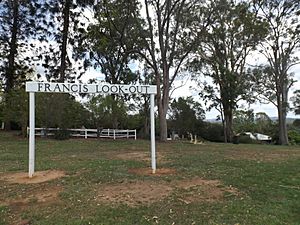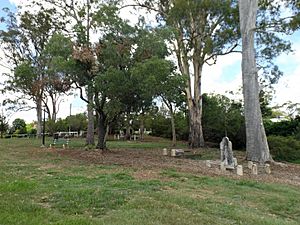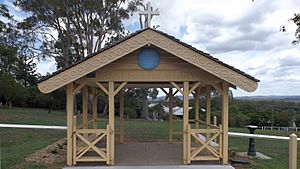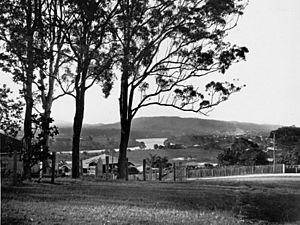Francis Lookout facts for kids
Quick facts for kids Francis Lookout |
|
|---|---|

Signage, 2014
|
|
| Location | 157 Dewar Terrace, Corinda, Queensland, Australia |
| Design period | 1840s - 1860s (mid-19th century) |
| Built | 1863 - 1966 |
| Official name: Francis Lookout, Francis Outlook | |
| Type | state heritage (landscape, built) |
| Designated | 7 September 2004 |
| Reference no. | 602441 |
| Significant period | 1860s-1960s (fabric, historical use) |
| Significant components | trees/plantings, headstone, fence/wall - perimeter, lychgate, burial/grave, fencing |
| Lua error in Module:Location_map at line 420: attempt to index field 'wikibase' (a nil value). | |
Francis Lookout is a special park and historic cemetery located in Corinda, Brisbane, Queensland, Australia. It sits on top of a hill at 157 Dewar Terrace. This site was used for burials between 1862 and 1966. It is also known as Francis Outlook and was added to the Queensland Heritage Register in 2004 because of its important history.
Contents
A Look Back at Francis Lookout
Francis Lookout is a park on a hill in Corinda. It holds graves from a long time ago, between 1862 and 1966. Arthur Morley Francis and his wife Angela were among the first families to live in the Corinda area. In 1862, they bought a large piece of land. This land stretched from the Brisbane River all the way up to where Francis Lookout is today.
The First Graves
The Francis family started this cemetery when their youngest son, Clement, died in 1863. They set aside one acre of land for burials. This was because there wasn't a public cemetery in the area back then. Arthur Francis was later buried here too. Their son, Richard (Dick) Francis, was also buried here. He was known as a hero for saving people during the big 1893 Brisbane flood. The last family member buried here was Mary Francis, Dick's wife, in 1937.
Other families also have graves in this cemetery. These include the Jones, Dunlop, Clarkson, Walker, and Gray families. There are also two graves that are no longer in their original spots.
The Lychgate: A Special Entrance
A lychgate is a covered gateway, often found at the entrance to a churchyard or cemetery. The lychgate at Francis Lookout was built by Angela Francis in 1902. She built it to honor her husband, Arthur Francis. Her friends helped carve the fancy wooden decorations on the gate. A small bronze sign on the gate says, "ERECTED BY ANGELA FRANCIS 1902."
The lychgate has a pointed roof, called a gable roof. It was first covered with wooden shingles. These were changed to concrete tiles in 1962, but now they are back to wooden shingles. The sides of the roof are covered with wooden boards. The original wooden floor has been replaced with concrete.
Becoming a Public Park
In 1930, the Brisbane City Council started looking after many cemeteries in Brisbane. Francis Lookout was still privately owned by Henry Alexander Francis and George Waugh. George Waugh asked the council to take over the cemetery. He agreed that the family would not ask for money if the council promised to take good care of the cemetery forever.
The council officially took over in 1934. They made improvements and repairs in 1935-1936. These included:
- Building a low fence along the roads.
- Fixing and painting the special shelter shed (the lychgate).
- Straightening and fixing the fence around the graves.
- Putting up a proper sign for the park.
What You Can See at Francis Lookout
Francis Lookout is a park located at the corner of Dewar Terrace and Hilda Street in Corinda. It used to be a private cemetery and still has several memorials. The timber lychgate was built in 1902.
The park is on a high hilltop, offering amazing views of Brisbane. You can see especially well towards Mount Coot-tha. The site is about 50 meters high, which is a good height for a lookout in Brisbane.
This lookout is a well-known spot in the Corinda area. You can even see it from across the river in Fig Tree Pocket. The area is mostly open and grassy, with a gentle slope towards one corner.
The fence around the park is white. It has strong wooden posts and two wires. The main entrance and corner posts are a bit bigger and have a pointed top.
There are many eucalypt trees here. These trees are special because they usually grow on rocky areas at higher elevations. There is also a large bunya pine tree, which was likely planted 40 to 60 years ago.
The site has 10 known graves and one grave that is no longer found. The five Francis family graves are together and surrounded by a white fence. The other graves are spread out to the north of these.
The lychgate is a small wooden building. It stands on strong wooden posts and has a gable roof covered with wooden shingles. The floor inside is made of concrete.
Why Francis Lookout is Important
Francis Lookout was added to the Queensland Heritage Register in 2004. This means it is a very important historical site.
It shows how Queensland's history developed. Francis Lookout helps us understand how the Corinda area grew in the mid-to-late 1800s. It was a farming community back then. The park's strong connection to the Francis family, who lived there from 1862, also shows how individuals helped shape Queensland's history.
It is a rare and special part of Queensland's history. This place is one of the few private burial grounds in the Brisbane area. It can teach us more about how the Corinda area was settled. It also shows us how people buried their loved ones in the 1800s and early 1900s. It gives us a glimpse into what life was like for pioneers.
It shows what a private cemetery looks like. Francis Lookout shows us the main features of a small, privately started cemetery. For example, it didn't have different sections for different religions. The people buried here were connected to the local area, especially the family who owned the land and their neighbors. Its design and grave markers are typical of cemeteries from the 1800s.
It is beautiful and important for its looks. The hilltop location of Francis Lookout offers amazing views of Brisbane. The well-designed wooden lychgate also adds to its beauty. Because of its lovely setting and design, Francis Lookout is important for its aesthetic (artistic) significance.
Important Gravesites
Francis Family Gravesite
Burials in the Francis family gravesite include:
- Arthur Morley Francis (1826-1902)
- Richard Powell Francis (1860-1893): He was a hero who saved people during the 1893 Brisbane flood.
- Mary Francis (died 1937): She was Richard Powell Francis's wife.
- Rebecca Francis (died 1892): She was the wife of Henry Alexander Francis.
- Arthur Clement, Angela Mary, Robert George (1866), and Dorothea (1877): These were children of Arthur Morley Francis and his wife Angela.
Gray Family Gravesite
Burials in the Gray family gravesite include:
- Lewis Mackie Gray (died 1895): She was born in Scotland in 1822 and married William Gray.
- William Gray (died 1902): He was born in Scotland in 1821. He studied law, medicine, and religion. When he arrived in Brisbane in 1862, he bought land in Corinda. He became the unofficial doctor and legal advisor in the area. He also became the first clergyman of St. Matthews Anglican Church in Sherwood.
Walker Family Gravesite
Burials in the Walker family gravesite include:
- John Higson Walker (died 1873): He was a land surveyor from England.
- Alice (Bleasdale) Walker (died 1902): She was John Higson Walker's wife.
- Maria Louisa Walker (died 1866): She was their daughter.
- Alice Helena (Amos) (died 1897): This is likely a memorial for their daughter, who has a grave elsewhere.
The death of their daughter in 1866 was probably why the family grave was placed in the Francis Cemetery. The public graveyard in Sherwood only opened in 1871.
Clarkson Family Gravesite
Burials in the Clarkson family gravesite include:
- Jane Morrow Clarkson (died 1896): She was the wife of Joseph Clarkson.
- Joseph Clarkson (died 1902): He was active in the Fig Tree Pocket area.
- Joseph Clarkson (died 1869): Their son, aged 15.
- Samuel Clarkson (died 1869): Their son, aged 8.
The Clarkson family lived across the Brisbane River from the Francis family. The deaths of their two sons, just days apart in 1869, likely led to their burial in the Francis Cemetery. The Sherwood graveyard was not open yet.
Dunlop Family Gravesite
Burials in the Dunlop family gravesite include:
- John Dudley Dunlop (died 1906): He was a carpenter and an early pioneer in Corinda. He built a community hall, which is now the Corinda Library.
- Maud Norton (died 1966): She was John Dudley Dunlop's sister, and this is a memorial plaque.
- Ceridwen Mair Williams (died 1966): She was Maud Norton's granddaughter, and this is a memorial plaque.
Jones Family Gravesite
Burials in the Jones family gravesite include:
- Mervyn Alban Jones (died 1902): He was a shipping inspector. He was known for safely guiding ships through dangerous waters near the Great Barrier Reef.
- Trevor Warwick Jones (died 1914): Although there is no headstone, records show he is buried here. He was a promising student who joined the army at the start of World War I. He became ill while in training camp and passed away. He is remembered on a plaque at the University of Queensland.




